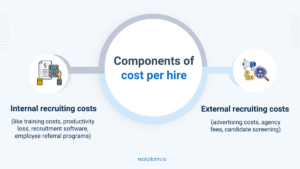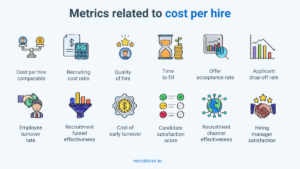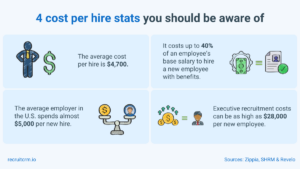The cost of onboarding a new employee often goes unnoticed, yet it plays a crucial role in a company’s financial health.
If you haven’t paused to crunch these numbers, the actual figures might surprise you.
In this article, you’ll gain an understanding of the fundamentals of cost per hire and its crucial role in business operations.
We’ll guide you through the process of effectively calculating it. Alongside, practical examples will be presented to clearly illustrate its impact.
Keep reading.
What is cost per hire?
Cost per hire (CPH) is a crucial metric that quantifies the total expenses involved in hiring new employees.
This includes everything from advertising job openings to the salaries of the hiring team.
But why is it considered a recruitment staple?
Simply put, it’s about efficiency and budgeting.
Knowing your CPH helps in strategic planning and resource allocation, ensuring that your recruitment process is not only effective but also cost-efficient.
Understanding recruiting costs: Major components of cost per hire

1. Internal recruiting costs
Internal recruiting costs include expenses incurred towards building a team of recruiters for your agency. These costs are often less apparent but significantly impact your average cost per hire. Let’s break down these costs:
- Salaries: This includes the wages paid to the recruiting staff involved in the hiring process.
- Training costs: These are the expenses associated with training the recruiting team. For example, costs for attending hiring workshops, webinars, or any other training programs aimed at enhancing their recruitment skills.
- Productivity loss: A hidden cost that many fail to consider. It represents productivity loss when recruiters are focused on recruitment and miss out on other responsibilities. This cost is more significant in smaller teams where every recruiter has multiple tasks to handle.
- Recruitment tools and software: Any internal tools or software used for recruitment, like applicant tracking systems (ATS), also contribute to internal costs. These tools can streamline the recruitment process but come with their own set of expenses.
- Employee referral programs: If the company has an employee referral program, the incentives or bonuses paid to employees for successful referrals are part of internal costs.
- Internal recruitment events: Costs incurred during internal recruitment events, such as career days, also fall under this category.
2. External recruiting costs
External recruiting costs are the expenses incurred outside your organization.
These are more visible and can vary widely based on the job role and recruitment strategy.
Key external costs include:
- Advertising costs: It encompasses the cost of posting job openings on job boards, social media platforms, or in traditional media like newspapers. The cost can vary based on the platform’s reach and the duration of the job ads.
- Candidate screening and testing: Expenses related to pre-employment tests, background checks, and skill assessments fall under this category. These are crucial for ensuring the quality of hires but add to the CPH.
- Travel and accommodation for candidates: If you’re interviewing candidates from out of town, the cost of their travel and accommodation is part of external costs.
- Job fairs and recruitment events: Participating in job fairs or hosting recruitment events involves costs like registration fees, booth setup, and promotional materials.
- Consultant and legal fees: Any legal advice or consultancy regarding recruitment, especially for specialized roles, is an external cost.
How to calculate cost per hire?
Calculating CPH goes beyond simple arithmetic; it’s about gaining insights into your recruitment process.
It involves a comprehensive approach, considering both direct and indirect costs.
We’ll delve into a step-by-step guide on how to calculate cost per hire.
A step-by-step breakdown of the formula
Step 1: Compile all expense data for the current period in question from HR documentation, invoices (both internal and external), and financial records.
Step 2: Categorize all the expenses under major heads and organize the same in an Excel sheet in a tabular format. Use Excel formula to sum up the costs automatically as you fill the sheet.
Step 3: Figure out the number of hires made during the relevant time frame.
Step 4: Calculate cost per hire using the straightforward formula mentioned below-
![]()
Note: The main challenge lies in accurately identifying what constitutes ‘Total recruiting costs.’ This includes both internal and external costs, as discussed earlier.
3 major examples of calculating CPH
Example 1:
Consider a company that incurs $50,000 in external recruiting and $30,000 in internal costs over a year and hires 20 new employees. The CPH calculation is:
CPH= ($50,000+$30,000)/20 = $4,000
This figure helps the company gauge the efficiency and effectiveness of its hiring process.
Example 2:
Imagine a tech firm that spends $70,000 on recruitment agencies, $40,000 on online job postings, and $20,000 on internal recruitment activities within a year. If the firm successfully hires 15 engineers, the CPH is:
CPH= ($70,000+$40,000+$20,000)/15 = $8,667
This higher CPH reflects the specialized nature of the roles and potentially the competitive market for tech talent.
Example 3:
For a retail company, let’s assume annual recruitment costs include $10,000 for job fairs, $5,000 for social media advertising, and $15,000 for internal recruitment processes. If they hire 50 employees throughout the year, their CPH would be:
CPH= ($10,000+$5,000+$15,000)/50 = $600
This lower CPH may be indicative of the industry’s broader talent pool and streamlined recruitment processes.
These examples demonstrate how cost per hire can vary significantly depending on the industry, the types of roles being filled, and the recruitment strategies employed.
6 different parameters for calculating cost per hire
1. Skill level and specialization
Industries requiring highly specialized skills often face higher cost per hire due to the limited talent pipeline and the need for competitive compensation packages to attract top talent.
2. Turnover rates
Sectors with high turnover rates, like retail and hospitality, might incur lower costs per hire but higher overall recruitment costs due to the need for frequent hiring.
3. Recruitment channels
Some industries rely heavily on professional networking sites and headhunting for specialized roles, which can be more expensive than traditional job postings.
4. Regulatory requirements
Niche job markets like that of healthcare and finance have stringent regulatory requirements, necessitating thorough background checks and longer recruitment processes, thereby increasing CPH.
5. Geographical factors
The location of the industry can also affect the average cost per hire. For instance, recruiting in major metropolitan areas might be more expensive due to higher living costs and competition for talent.
6. Economic and market trends
Economic fluctuations and market trends can significantly impact CPH. For example, during a tech boom, the demand for software developers rises, increasing the cost per hire in the tech industry.
12 advanced metrics related to cost per hire

1. Cost per hire comparable (CPHC)
CPHC is an advanced metric that compares the average cost per hire across different departments or locations within the same organization. This comparison can provide valuable insights into the efficiency of different recruitment strategies.
2. Recruiting cost rate/ratio (RCR)
RCR is another critical stat that measures the cost of recruitment against the total salary of new hires. It provides a broader perspective on the impact of recruitment costs relative to the value of the hires.
3. Time to fill (TTF)
TTF measures the average time it takes to fill a position, from the job posting to accepting an offer. A shorter TTF can indicate efficient recruitment processes, whereas a longer TTF might suggest areas for improvement in the recruitment strategy.
4. Applicant drop-off rate (ADR)
ADR tracks the percentage of candidates who start but do not complete the application process. A high ADR could indicate issues with the application process or candidate experience.
Also read: Lower your candidate drop-off rates effectively [6 sure-fire ways]
5. Quality of hire (QoH)
This calculation helps assess the value new hires bring to the company. It can be measured through various factors such as performance ratings, retention rates, and contribution to business objectives. QoH helps in understanding the effectiveness of the recruitment process in selecting the right candidates.
6. Offer acceptance rate (OAR)
Here, the ratio measures the percentage of candidates who accept a job offer. A high OAR suggests that the company is offering competitive packages and has a strong employer brand.
7. Employee turnover rate (ETR)
This metric measures the rate at which employees leave the organization. While not directly a recruitment metric, it can indirectly indicate the effectiveness of the recruitment process in hiring the right fit for the company.
8. Recruitment funnel effectiveness (RFE)
RFE analyzes the effectiveness of different stages in the recruitment funnel, from initial application to final hire. It helps in identifying bottlenecks and inefficiencies in the recruitment process and candidate journey.
9. Cost of early turnover (CET)
CET represents the cost associated with an employee leaving the company shortly after being hired. This includes costs of re-hiring, training, and lost productivity. A high CET can indicate issues with the recruitment or onboarding processes.
10. Candidate satisfaction score (CSS)
This particular statistic reflects the satisfaction level of candidates with the recruitment process. A positive candidate experience can enhance the employer brand and attract more quality applicants.
11. Recruitment channel effectiveness (RCE)
RCE evaluates the effectiveness of different recruitment channels in terms of the quality and quantity of candidates they bring in. This helps in optimizing the allocation of resources to the most productive channels.
12. Hiring manager satisfaction (HMS)
This stat evaluates the satisfaction of hiring managers with the recruitment process and the candidates hired. It provides insights into how well the recruitment team understands and meets the needs of different departments.
By incorporating these advanced metrics into your recruitment analysis, you can gain a comprehensive understanding of your recruitment process’s strengths and areas for improvement.
Why is it even important to track CPH: 8 practical applications of cost per hire data
1. Budget allocation
CPH data helps in accurately forecasting the budget required for future hiring.
By understanding the average cost to hire an employee, organizations can allocate their resources more effectively, ensuring that sufficient funds are available for recruitment without overspending.
You might also like: How to set your recruitment budget for 2024?
2. Identifying efficiency gaps
Analyzing CPH data can highlight areas where the recruitment process may be less efficient.
For instance, if the average cost per hire is significantly high, it might indicate an over-reliance on expensive recruitment agencies or inefficient use of advertising budgets.
3. Guiding recruitment strategy
CPH data can inform the development of recruitment strategies.
For example, if advertising costs are a major component, the company might explore more cost-effective recruitment channels like social media or employee referrals.
4. Performance measurement
CPH can be used as a metric to measure the performance of the recruitment function. Over time, a decreasing trend in cost per hire can indicate improved efficiency and effectiveness of hiring strategies.
5. Internal benchmarking
Comparing CPH data across different departments within the organization can provide valuable insights.
For example, if one department has a significantly lower cost per hire, its practices can be analyzed and potentially adopted by other departments.
6. Competitive benchmarking
Analyzing your organization’s average cost per hire against industry benchmarks and competitors provides a sense of where you stand in the market.
This comparison can reveal whether your recruitment costs are competitive and where improvements can be made.
7. Strategic positioning
Understanding how your cost per hire compares to industry averages can help in strategically positioning your organization as an employer.
For instance, a lower-than-average ratio could be a sign of efficient recruitment practices, which can be a selling point in attracting top talent.
8. Decision-making
CPH data, when scrutinized in comparison to competitors and industry benchmarks, can guide strategic decisions, such as whether to build an in-house recruitment team, invest in new recruitment technologies, or revise the existing recruitment process.
Recruitment as an industry is heavily driven by metrics– and the average cost per hire is definitely one of the leading ones on the list.
4 crucial statistics on cost per hire

Frequently asked questions
1. What is considered a good cost per hire?
A ‘good’ cost per hire varies by industry and company size. It’s more about how it aligns with your company’s budget and recruitment goals. The ideal CPH for your industry might be a good indicator of how your company is thriving and what measures to take.
2. Can cost per hire be reduced without compromising on the quality of hires?
Absolutely. It’s about optimizing your recruitment process and spending wisely, not necessarily spending less. The sole purpose of calculating cost per hire lies in how efficiently you end up allotting the expenses for optimum results.
3. How often should cost per hire be calculated?
It’s advisable to calculate CPH annually for a consistent overview, but also after major recruitment drives to assess their impact. It helps your team to stay on track with the efficiency of your budget allocation decisions.




